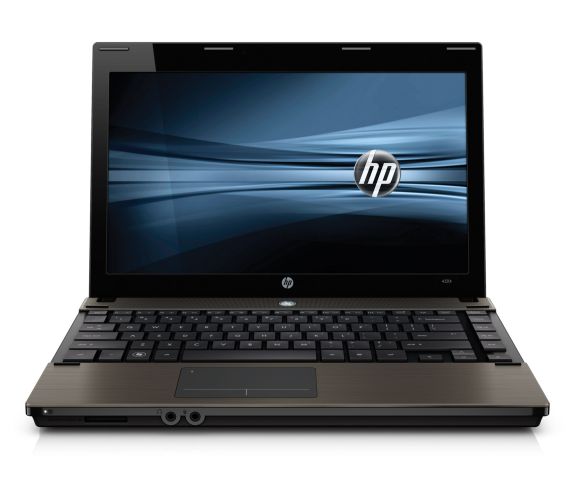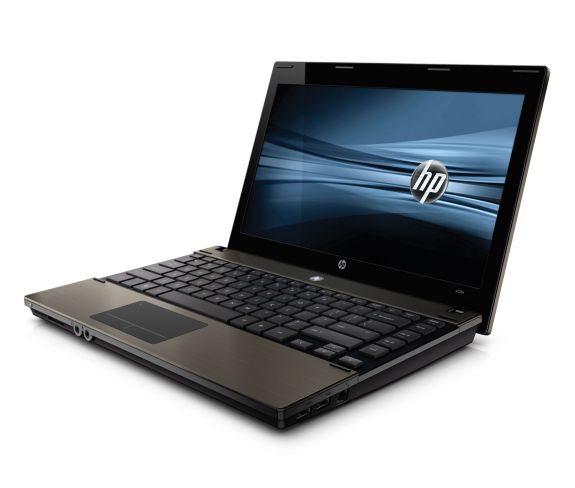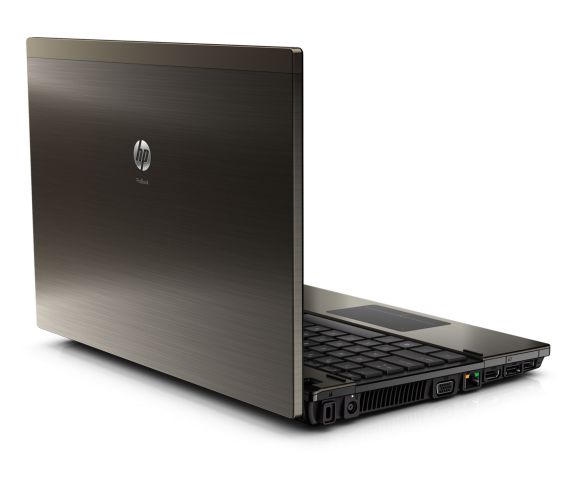Announcing: HP 4320t Mobile Thin Client
by Balraj Sandhu on May 12, 2010 12:01 AM EST- Posted in
- Laptops
- IT Computing
- Intel
- HP
- Announcing
HP 4320t Mobile Thin Client
After launching many consumer and business notebooks last week, HP have announced a further addition to their growing notebook family. The HP 4320t Mobile Thin Client is aimed at the user who regularly accesses servers and other remote storage solutions, and therefore requires a thin, light and reliable notebook where onboard storage is not a concern.
The highlight of this notebook is the brushed aluminum chassis, which HP claim will improve durability. Meanwhile a 13.3” LED-backlit display featuring a relatively lowly resolution of 1366x768 will probably be adequate for the target user.
Performance comes from a 1.8GHz Intel Celeron (presumably P4500) processor on the Intel HM57 Chipset with support for up to 4GB DDR3 RAM. As the primary use of this notebook will be to access remote storage, internal storage is kept to just 2GB or 4GB of solid state memory. An optional DVD drive is available.
Connectivity comes in the form of three USB 2.0 ports, a USB/eSATA combo port, VGA, HDMI, ExpressCard/34, media card reader, microphone and headphone ports. Networking is plentiful with wireless 802.11a/b/g/n and wired gigabit Ethernet with an optional integrated 56K modem. The notebook also incorporates an integrated digital microphone and stereo speakers.
The notebook features a spill-resistant chiclet-style keyboard and touchpad. Long battery life is a must for this type of notebook; for this HP offers 6 cell (47WHr) and 9 cell (93WHr) options for mobility or extra long battery life. They don't specifically state an estimated battery life, but we'd expect the 6-cell battery to last at least five hours for typical business workloads.
The notebook comes with preinstalled software aimed at enhancing the server-client interaction. This includes the Windows Embedded Standard 2009 operating system and software such as File Based Write Filter and Enhanced Write Filter, and HP Virtual Client Essentials.
The HP 4320t Mobile Thin Client will be available in late May from $599. As a notebook entirely orientated around network storage, it seems to fit the bill. However, should that same notebook find itself stranded from its server, that price tag would buy you a much faster notebook with plenty of onboard storage and Windows 7 in the consumer market which would provide a much richer multimedia experience. So the question the target audience will need to ask is whether that slim aluminum chassis and preinstalled software make it worth the same price as a higher spec, more versatile, mainstream notebook?
In my opinion, probably not. Perhaps even more shocking is that despite the "Thin Client" name, the 4320t is actually thicker and heavier than the ProBook 5310m we looked at last month. For those interested, the full specifications are listed below.
| HP 4320t Mobile Thin Client Specifications | |
| Operating System | Windows Embedded Standard 2009 |
| Processor | Intel Celeron ( 1.8GHz, 2MB L2 cache) |
| Chipset | Mobile Intel HM57 Chipset |
| Memory |
Up to DDR3-1333 (depending on CPU) dual-channel memory Supports 1024/2048/4096MB SO-DIMMs, up to 4096MB standard |
| Internal Storage | Solid State Flash Module: 2GB, 4GB |
| Removable Storage | Fixed 12.7mm SATA DVD-ROM optical drive (optional) |
| Display | 13.3" diagonal LED-backlit 16:9 HD (1366 x 768) |
| Graphics | Intel HD Graphics |
| Battery/Power |
6-cell (47WHr) Lithium-Ion battery 9-cell (93WHr) Lithium-Ion battery 65W HP Smart AC, HP Fast Charge |
| Audio/Visual |
HD Audio Stereo speakers Integrated digital microphone |
| Wireless Support |
Broadcom 802.11 a/b/g/n Broadcom 802.11 b/g |
| Communications |
Realtek Ethernet (10/100/1000 NIC) optional 56K v.92 modem |
| Expansion Slots |
ExpressCard/34 slot Media Card Reader |
| Ports and Connectors |
3 x USB 2.0 ports 1 x eSATA/USB 2.0 combo port VGA HDMI Stereo headphone/microphone Power connector RJ-11/modem RJ-45/Ethernet |
| Input Device | Full-sized keyboard, ClickPad |
| Software |
Standard: Internet Explorer 7, Windows Media Player 11, File Based Write Filter, Enhanced Write Filter, WinDVD, Microsoft Remote Desktop Protocol, Citrix XenApp, VMWare View, Terminal Emulation Software, Symantec Endpoint Security Manageability Solutions: HP ThinState Tools, HP Device Manager, HP Client Automation – Starter Edition, Altiris Deployment Client6 HP Virtual Client Essentials: HP Remote Desktop Protocol Enhancements, HP Remote Graphics Software |
| Security | Kensington Lock slot2, HP Privacy Filter Support |
| Dimensions | 1.08" (at front) x 12.74" x 8.98" / 27.49mm (at front) x 323.50mm x 228.08mm |
| Weight | Starting at 4.27 lb/ 1.93 kg (with weight saver; weight will vary by configuration) |













29 Comments
View All Comments
Zok - Wednesday, May 12, 2010 - link
I expected this to be an actual review or, perhaps, a "This Just In:," but it was neither. Maybe add a "Just Announced:" or something to the title. I got halfway through the article before I realized that nothing was actually being reviewed.Zok - Wednesday, May 12, 2010 - link
Thanks for changing it to "Announcing:"!Please make the check payable to Jack Bauer.
Stokestack - Thursday, May 13, 2010 - link
"Thin client"? Ha ha ha! Welcome to the buzzwords of 15 years ago. And with a Celeron, you pretty much have a the performance of a computer from that era too.Yawgm0th - Monday, May 17, 2010 - link
A 1.8GHz Celeron would be about as powerful as a dodeca-processor server of 1995. Even in relative terms to today's software, it's probably way more powerful than thin clients and even most desktops of the day.Also, thin client environments aren't uncommon, and in fact can be a great way to cut administration and hardware costs down if the application doesn't call for a full desktop. If anything, this system will probably be too powerful and expensive for many businesses users. It's hardly a buzz word.
ksherman - Wednesday, May 12, 2010 - link
Hmm, in my book >1" thickness (even at the front) is not really what I'd call a "thin" client...ksherman - Wednesday, May 12, 2010 - link
BUT, I do think it looks pretty nice, from a style stand point.Samus - Wednesday, May 12, 2010 - link
2GB/4GB is totally ridiculous. You can't even cache the average exchange mailbox to that. And no, not everyone is expected to use OWA. This thing is totally useless for business. It's basically a fancy first generation eee 900, which still even had more storage capacity.My point is, with the cost of 8GB, 16GB or even 32GB NAND ($40/$60/$100 respectively) how much more would it really be for HP to NOT order bulk 2GB/4GB flash modules and just get 32GB modules instead. I'm sure they're spending at least $30 on the 4GB modules.
Chloiber - Wednesday, May 12, 2010 - link
I also think that 2/4GB of STORAGE is really ridiculous. I mean - the cheapest iPod has more...Justin Time - Wednesday, May 12, 2010 - link
I think you are missing the point.The 't' models are intended as mobile terminals, not as functional stand-alone notebooks.
Very specific niche market in the business sector.
nao1120 - Wednesday, May 12, 2010 - link
RE: RE: RE: "Thin" Client? by Justin Time on Wednesday, May 12, 2010
I think you are missing the point.
The 't' models are intended as mobile terminals, not as functional stand-alone notebooks.
Very specific niche market in the business sector.
I agree - 2 to 4 gb of flash storage memory on the unit is designed to hold the OS, and apps needed to connect to servers and nothing else....The entire point of thin clients, is to offer a device to connect to remote servers....
And to comment on where you could store you OWA, and email and exchange issues. That is solved by other solutions, such as file servers, and citrix ....
It does work well, and its currently used on our environments.
It is like its designed for, a dummy terminal, with a sceren/ and keyboard, but in this case, mobile....which is lets face it....Nice.